|
|
|
 |
|
| Hanwei Practical Basket Hilt Broadsword (SH2059) |
Points: 15
|
The Practical Mortuary Hilt and Practical Basket-Hilt swords are built for the re-enactor. The baskets are identical to the edged versions, but the blades are unsharpened, with 1/16" safety edges and rounded tips, complying with the combat rules of many re-enactment societies. The blades are crafted in 1065 high-carbon steel, hardened to 50HRC, which reduces edge-notching to acceptable levels while providing resilience and protection against brittleness. The scabbards are finished in matte black, ready for owner customization if desired.
|
|
|
|
|
|
 |
|
| Hanwei Practical Mortuary Hilt Sword (SH2076) |
Points: 13

|
The Practical Mortuary Hilt Sword (SH2076) is built for the re-enactor. The basket is identical to that of the SH2004 but the blade is unsharpened, with 1/16" edged and a rounded tip, complying with the combat rules of many re-enactment societies.
|
|
|
|
|
|
 |
|
| Hanwei Practical Side Sword (SH2279) |
Points: 15
|
The Practical Side Sword (SH2279) uses the same hilt as the sharp version(SH2203), but carries a sparring blade designed for safety. Side sword sparring, in both sword & buckler and sword & dagger modes is becoming increasingly popular with many proponents among the ranks of the various Renaissance societies.
The Side Sword was a military sword of the 16th and 17th century Renaissance period that also achieved popularity among civilians, due to its relatively light weight and quickness. It also had an advantage over its contemporary, the rapier, in having the ability to cut efficiently as well as thrust. Side swords were often the weapon of choice for sword and buckler fighting. Our side sword, based on a German original, is a beautifully proportioned piece that balances very well. The "swept" hilt affords excellent hand protection and the blade geometry makes for outstanding performance in both the cut and the thrust. Includes black leather scabbard.
|
|
|
|
|
|
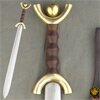 |
|
| Hanwei Celtic Sword (SH2370) |
Points: 11

|
Our Celtic Sword has an anthropomorphic hilt and leaf-shaped blade. Solid brass hardware, a macassar ebony grip and leather scabbard make this piece ideal for the Celtic persona. Iberia Swords are crafted in much the same way as swords were made centuries ago, except that the blades are now forged from high-carbon spring steel, a resource unavailable off-the-shelf to the smiths of the old. The blade finish is far from being polished, again more closely replicating what the medieval swordsmith was able to achieve. Except as noted, grips are leather-covered hardwood. Fittings are either steel or solid brass. Except, where shown all of these swords have scabbards of leather-covered fiberglass with steel lockets and chapes and removable suspension rings. These swords will appeal to the re-enactor who wants a sword with the same appearance as the originals.
|
|
|
|
|
|
 |
|
| Practical Scramasax (SH2297) |
Points: 6
|
The Practical Scramasax has been produced in response to many requests from Viking re-enactors. Its 12" blade, with a rounded tip and 1/16" wide edge, make it an ideal secondary weapon. A horizontal-carry scabbard is provided.
|
|
|
|
|
|
 |
|
|
|
|
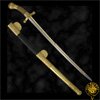 |
|
| Hanwei Charlemagne Saber (SH2288) |
Points: 30

|
The "Saber of Charlemagne the Great" is a vital part of European history, being an important artifact in the Insignia of the Holy Roman Empire, of which Charlemagne was the first Emperor. The saber is housed today, together with the rest of the imperial insignia, in the Kunsthistoriches Museum in Vienna. The sword is of Eastern European origin, dating from the first half of the 10th century. How it became a part of the insignia is not known but its lavish decoration indicates that it was made for an important member of the nobility. It is clearly a cavalry saber, indicative of its origins in the Eurasian Steppes.
CAS Hanwei's version of the saber is faithful in detail to the weapon as it was conceived, even to the point of omitting the decorative 15th century repairs that render the original unusable.
|
|
|
|
|
|
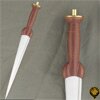 |
|
| Hanwei Scottish Dirk (SH2363) |
Points: 8
|
The ever-popular Early Dirk is strikingly authentic, its clean lines and carved hardwood hilt making it a clansman re-enactor favorite. Iberia Swords are crafted in much the same way as swords were made centuries ago, except that the blades are now forged from high-carbon spring steel, a resource unavailable off-the-shelf to the smiths of the old. The blade finish is far from being polished, again more closely replicating what the medieval swordsmith was able to achieve. Except as noted, grips are leather-covered hardwood. Fittings are either steel or solid brass. Except, where shown all of these swords have scabbards of leather-covered fiberglass with steel lockets and chapes and removable suspension rings. These swords will appeal to the re-enactor who wants a sword with the same appearance as the originals.
|
|
|
|
|
|
 |
|
| Templar Dagger (SH2364) |
Points: 7
|
The Templar Dagger is a solid sidepiece. Its solid brass fittings and black leather scabbard will complement period garb beautifully. Iberia Swords are crafted in much the same way as swords were made centuries ago, except that the blades are now forged from high-carbon spring steel, a resource unavailable off-the-shelf to the smiths of the old. The blade finish is far from being polished, again more closely replicating what the medieval swordsmith was able to achieve. Except as noted, grips are leather-covered hardwood. Fittings are either steel or solid brass. Except, where shown all of these swords have scabbards of leather-covered fiberglass with steel lockets and chapes and removable suspension rings. These swords will appeal to the re-enactor who wants a sword with the same appearance as the originals.
|
|
|
|
|
|
 |
|
| Hanwei Scottish Court Sword (SH1214) |
Points: 12

|
Quick and elegant describe the Scottish Court Sword. Replicating an original dating from the 1730's and belonging to an officer in Prince Charles Edward Stuart's army at Culloden, the finely chiseled silver-plated hilt and three-edged hollow ground blade exemplify the consummate skill of the swordsmiths of the period. See model SH2324 for the Practical Fencing Court Sword.
|
|
|
|
|
|
 |
|
| Hanwei Scottish Basket Hilt Broadsword (SH2002) |
Points: 15
|
Although Basket-Hilt swords appeared throughout Britain from the mid-sixteenth century on, their association with the seventeenth and eighteenth century Scottish highlander has become legendary.
Our Basket-Hilt Broadsword, replicated from an original in the collection of the Royal Armouries in England, carries a typical Glasgow-style hilt from the mid-18th century. It is likely that the blade of the original sword, marked "Andrea Ferara", was made in Germany a century earlier and re-hilted as basket designs were refined.
|
|
|
|
|
|
 |
|
| Hanwei Scottish Basket Hilt Backsword (SH2003) |
Points: 24
|
Early highland swords almost invariably carried the double-edged "broadsword" blade, but by the time of the Battle of Culloden (1746) the single-edged "backsword" was at least equal in popularity.Our Basket-Hilt Backsword, replicated from an original in the collection of the Royal Armouries in England that dates from about 1760, has an unusual basket with twin engraved "horned beastie" plaques and a blade with twin fullers running most of its length. The blade is German in origin, but the hilt and blade are contemporary.
|
|
|
|
|
|
 |
|
| Hanwei Scottish Claymore (SH2060N) |
Points: 18
|
Mainstay of the Highland warriors of the late 15th and 16th centuries, the Claymore had a uniquely styled hilt that sets it apart from other great swords of the period. Typically of hand-and-a-half length, this versatile weapon could deliver great sweeping slashes or powerful thrusts. Replicated from a surviving museum piece our Claymore is classic in its design, with distinctive sloping quillons terminating in quatrefoils and a high-collared quillon block with langets following the blade fuller. The leather-covered grip is topped by a globate pommel. The sword is available in both polished and antiqued finishes, the finish of the SH2060N closely replicating that of the original museum piece. The grips of the Claymore are leather-covered, black in the case of the SH2060 and brown for the SH2060N. Originally carried slung on the back, the Claymore matches perfectly with our OL1038/OL1038B back scabbard.
|
|
|
|
|
|
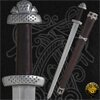 |
|
| Hanwei Trondheim Viking (SH2296) |
Points: 40

|
Hanwei continues to push the envelope with its forging capability in the Trondheim sword, produced as a one-piece forging in pattern-welded high-carbon steel. Patterned after swords that have been discovered in the area around Trodheim, Norway, the sword exhibits early ninth-century styling, a time when the Norwegian Vikings were pillaging Britain and Ireland. The beauty of the blade is matched by the grip and scabbard, both of which are wrapped in top-grain leather, engraved in a classic Viking motif.
|
|
|
|
|
|
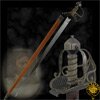 |
|
| Hanwei Cromwell Sword (SH1049) |
Points: 15

|
Oliver Cromwell (1599 - 1658) was a powerful figure in English history during and after the English Civil War, when he rose from the rank of Captain of Horse to Lord Protector of England. His sword, said to have been carried at the battle of Drogheda in 1649, has been remarkably well preserved and features in the collection of the Royal Armouries in Leeds, England, where it is displayed in the permanent collection. Our Cromwell Sword is an accurate replica of the original "mortuary" hilt style and features a blackened guard decorated in a gold foliage pattern with a wire-wound sharkskin grip. As the original sword now lacks a scabbard , we have provided a design typical of the period. This piece of English history is a must for the ECW collector and re-enactor.
|
|
|
|
|
|
|
|
Tags:
swords, sword, katana, wakizashi, tanto, japanese sword, medieval sword, viking sword, japanese swords, medieval swords, viking swords, knife, knives, saber, armour, movie swords, movie replicas, martial arts, sporting goods, sporting equipment,
|

















